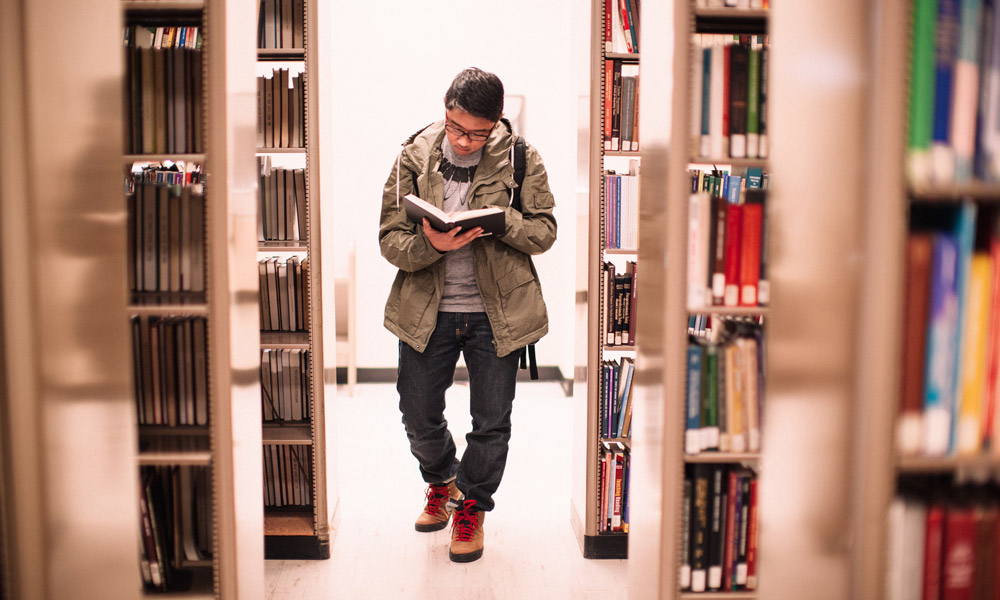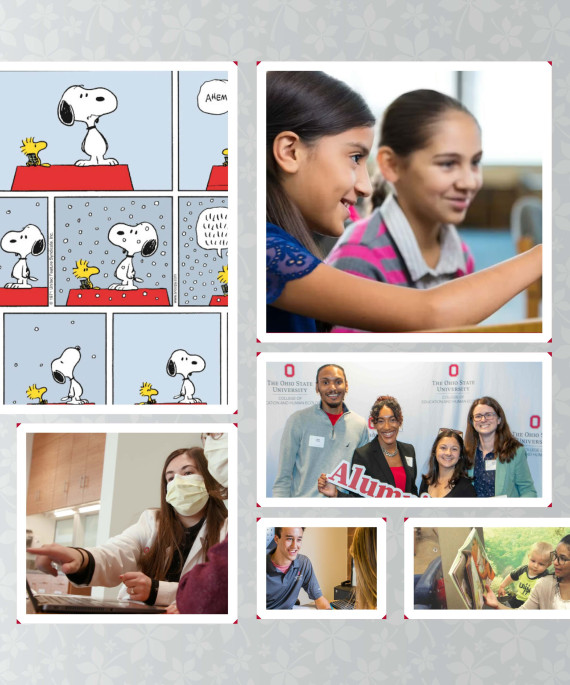
It’s time for a reality check on the stress facing college students
First the bad news. More students than ever say they experience “overwhelming” anxiety — 63% in 2018, according to the American College Health Association. That number bears out at Ohio State, where 60% of college students say that anxiety is their No. 1 mental health concern.
Any first-year student will tell you the reasons are many: Increased academic pressure. The stress of ‘being perfect’ played out on social media. Student debt.
Most of these pressures are firmly established well before students begin their first semester. According to Pew Research, 70% of teens 13 to 17 consider anxiety and depression the most major problem facing their peers — more than bullying, drug addiction, poverty and teen pregnancy. High school students are twice as likely to seek mental health treatment as teens did in the 1980s.
“We've raised a generation that's never been without 24-hour news cycles and terrorism, so it's constant insecurity through the media,” said Paul Granello, associate professor of counselor education. “Things like school shootings appear to be random and young people are on edge all of the time — starting in elementary school if they have active-shooter drills.”
What makes anxiety so complex?
Some argue that previous generations had plenty of worries, too: the draft, campus unrest, sexual violence, alcoholism. And while the internet and social media create stress, technology also provides education resources that former students couldn’t fathom.
But time and connectivity also have dealt some new and troublesome blows to the student psyche.
Students witness global warming, extreme political polarization and episodes of gun violence played out in graphic detail, on a news loop and on multiple media platforms.
“I didn't have to grow up worrying that our planet was being destroyed,” said Darcy Haag Granello, professor of counselor education. “I didn't grow up worrying about politics and division, the way they are. I didn't grow up worrying about some very real safety, life-and-death concerns that they're worried about.”
But how students process that worry depends on who they are and what they’ve experienced.
Females are twice as likely to seek treatment for anxiety and other mental health concerns as their male counterparts. But that doesn’t mean males aren’t experiencing it, said Tyler Hudson, a doctoral candidate in counselor education who helps run Ohio State’s Stress Management and Resiliency Training Lab, a resource for overwhelmed students.
“On the whole, men seek help less. So, when they do, their symptoms are usually a lot more acute,” he said.
Teens and adults who experienced trauma as children are much more likely to suffer from anxiety and other health issues. As many as 60% of Americans are at risk because they’ve had what experts call adverse childhood experiences — parental divorce, physical and emotional abuse and neglect, for example.
Brett Zyromksi, assistant professor of counselor education, studies how childhood trauma can affect mental health over a lifetime. During adversity, he said, the brain shuts down higher-order thinking and goes into fight or flight mode. Teachers see this play out in schools.
Need help with anxiety?
- The SMART Lab, in 445 PAES Building, helps students monitor their stress levels and implement coping mechanisms. Sign up for individual or group instruction.
- The Dennis Learning Center, 250 Younkin Success Center, 1640 Neil Ave., provides academic coaching to help reduce testing anxiety.
- The Student Wellness Center, B130 Recreation and Physical Activity Center, offers wellness coaching to support students with empowering conversations about strengths and goals.
- Counseling and Consultation Service, offers free drop-in counseling as well as scheduled appointments. For after-hours consultation, call 614-292-5766, and choose option 2.
“Students are triggered and their behaviors and their emotions are escalated. They're going into the brainstem. They're no longer able to process the information.”
The person next to them might regulate the same stress very well. But students who’ve suffered adversity can have prolonged, elevated anxiety. “The next thing happens and they're triggered up even higher, and now they're in an advanced state of stress and anxiety,” he said.
If college students don’t get a handle on anxiety, they can develop generalized anxiety disorder, testing anxiety, panic and eating disorders and depression.

Now, the good news — how to deal with anxiety
Key to preventing crippling anxiety are what researchers and mental health experts call “protective factors” — buffers like optimism, coping skills, spiritual beliefs and social supports.
“Even if you have all these risk factors, the protective factors you have and how resilient you are make a difference,” said Kisha Radliff, associate professor of school psychology. “If two kids have the same risk factors, but one has really great protective factors and the other not so much, the one with protective factors and who is resilient will be more successful in how they cope.”
Many of those factors center on family and community. Researchers discovered years ago that certain ethnic groups are more inoculated against anxiety than others. Some say that’s because those minorities have been to the school of hard knocks: Dealing with racial microaggressions and external threats like gang violence makes a tough midterm seem like no big deal.
“There’s a level of resiliency and out of that resiliency comes survival,” said James L. Moore III, EHE Distinguished Professor of Urban Education and Vice Provost for Diversity and Inclusion for the university. “If they don’t have that resolve, it’s going to be difficult emotionally and psychologically. Suburban or privileged kids, regardless of race, do not always learn the same coping mechanisms as urban kids, particularly those from low-income and working-class communities.”
But can they be?
Regardless of setting, researchers have determined that ethnic identity bolsters resilience and coping skills among people of color. Informal safety nets — offered through the black church communities and extended Latino families — can play a role. Research is limited on college students of color, but if ethnic affirmation creates a sense of belonging that counteracts anxiety, maybe that can be replicated in a college setting.
“These are things we can do in college to try to create belonging,” Zyromski said. Students can join dorm groups, take advantage of second-year transformational experiences, connect with peers and mentors in professional and recreational student groups. Professors can work harder to make students feel valued.
The point is to be active — not just join — in a variety of social situations, Radliff said. The more connected and affirmed a student feels, the less anxious, research shows.

When the heat is on
The next step is learning to reframe stress and cope with it.
There is a difference between an anxiety disorder — which is debilitating — and day-to-day anxiety. Some stress is a given, Hudson said.
“What is not a given is how we cope with it,” he said. “We can do so in positive, neutral or toxic ways. If we don't decide ahead of time how we're going to cope with stress, we're going to do so in a negative way.”
When handling college anxiety, there’s a sweet spot. A little anxiousness can spur you to work harder and study more. A lot can drive up your heart rate, cause chest tightness, nausea and a sense of doom.
Fortunately, Ohio State has many resources. The Dennis Learning Center offers free one-on-one appointments for students anxious about academics. Wellness Coaching helps students enhance their holistic wellness and health.
The SMART Lab — available to all students — offers mindfulness and meditation training. It also teaches students to use biofeedback to override evolutionary responses that for ages have sent humans running from danger.
Wearing earlobe sensors, the students watch colorful depictions of their heart-rate variability, or spaces between heartbeats. Red means stress; green signals that the rate is minus erratic variations that make people edgy. Drawing in deep and even breaths kicks in a parasympathetic response — throwing the brakes on the fight-or-flight reaction that triggers stress. The color wheel becomes outlined in green. Calm.
True relaxation is more than bath balms and Netflix, Hudson said. “If you really want to get the physiological and emotional benefits, it takes intentional effort and concentrated engagement.”
The purpose of the SMART Lab is to swim upstream, Paul Granello said, teaching students stress management, coping skills and resiliency skills so that they won’t need mental health services.
“The more we can intervene with people earlier, the better,” he said. “Why wait till people are about to go over the waterfall before you intervene?”
Especially because anxiety is so treatable.
“The wonderful thing about anxiety,” said Darcy Haag Granello, “is these are incredibly manageable disorders, mostly treatable without medication, with very specific, very clear strategies that can help people manage their anxiety. That's fantastic.”




